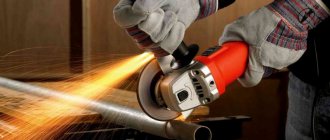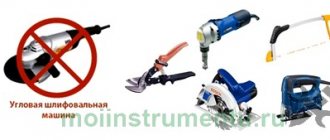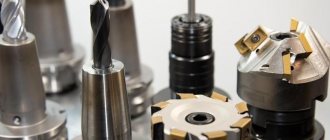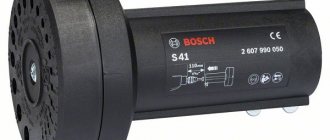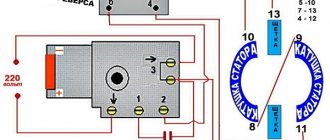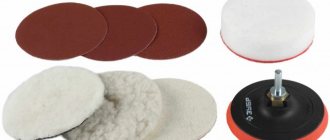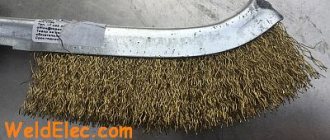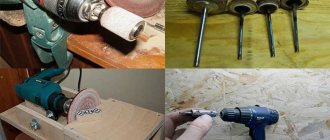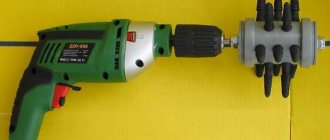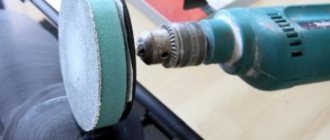A drill is one of the most versatile tools on the farm. With its help, you can even carry out polishing and grinding work by choosing a special attachment. We will learn about the advantages and disadvantages of using attachments instead of the whole tool, about their types and areas of application. Let's figure out which drill attachment for grinding is suitable for which work, what types exist and what materials are used.
Attachments for small work Source main-cdn.goods.ru
Features of using grinding attachments
The drill is often used when performing construction and repair work. Having different attachments for the drill, it can not only drill, but also grind, polish and clean surfaces.
Grinding attachments are used in different cases:
- For polishing metal and wood, can be used on painted or varnished surfaces;
- Grinding small metal products or those located in difficult places;
- Treatment of primed surfaces;
- Cleaning from rust, old varnish or paint;
- Cleaning hard-to-reach places from defects;
- Polishing glass and grinding its edges.
Different attachments are used for each purpose, but in general, purchasing them will cost less than purchasing an additional grinder.
“Plate” Source instrument-club.ru
Using sanding attachments on a drill has its pros and cons. The first include:
- Possibility not to buy additional equipment. If you only need to clean the surface once during repairs, it is better to use an existing drill rather than buying a device that will be useless in the future.
- Low price of the nozzles themselves. You can buy many types to work with different materials.
- A large selection of attachments makes it easy to choose the right one for a specific job. Diversity allows you to replace several tools at once.
There is only one drawback: in comparison with professional tools, a drill with an attachment has low speed and productivity. It will not cope with a huge amount of work, but will perform well during repairs or construction in a private house or garage.
“Bowl” Source mozmarket.ru
See also: Catalog of companies that specialize in finishing materials and related work
Areas of application for drill grinding attachments
In many cases, grinding attachments for drills quite successfully replace specialized grinders, which allows the home craftsman to get by with a minimum of power tools when solving his problems. For example, you can use a wire brush to remove rust or old paint, then use a pad of abrasive paper to sand the surface before and after priming, then buff the paint using felt or felt. If you need to install a similar attachment on a screwdriver, use special chucks with a hex shank or adapters. The only limitation of such a tool is the low speed of the screwdriver.
The presence of abrasive rollers of various shapes allows you to bore a hole in the metal to the desired size or give it the required shape. These drill attachments come in many shapes and sizes, so you can always choose one that matches the size and shape of the profile being machined. Sanding plates and drums are often used with a drill secured using special devices in a horizontal or vertical position.
In this version, the drill acts as an improvised mini-sharpener, which can be used both for grinding parts and for sharpening tools.
Types of nozzles
Attachments for drills for grinding are made according to the same principle as replaceable blocks for polishing machines. They differ in the type of fastening: in special machines a thread is used, on a drill the fastening is made using a pin.
There are several types. The choice of a specific one depends on the material and the required operation.
Plate
Round nozzle with sandpaper. The latter varies in graininess and hardness. When working, the drill must go strictly at right angles to the surface. When tilted, defects and damage will appear on the tree. For convenience, some “plates” adjust the angle themselves.
“Disk” Source: vashinstrument.com
Cup
The cup attachment for a sanding drill looks like a brush with long metal bristles. The shape resembles an inverted cup made of plastic or metal. There are also “bowls” with soft filling.
It performed well when working with wood. Metallic fibers release the fibers of the material, which well emphasizes the wood structure. The result is a natural look.
Purpose of grinding wheels
Types of grinding wheels
The scope of application of these processing tools is wide. They differ not only in appearance, but also in the manufacturing method. Using grinding wheels, you can remove a small amount from the surface of the workpiece, thereby improving the technical and operational characteristics and appearance.
Many materials and tools fall under the definition of a grinding wheel. Therefore, it is advisable to consider the most common of them. For domestic purposes, end-mounted ones are most often used, which are installed on a drill. In addition, you should take into account the product labeling, the possibility of use on special sharpening machines, and size.
Methods of using grinding wheels depending on marking and composition:
- grinding the surfaces of various parts and workpieces. The degree of processing depends on the grain size, total contact area and rotation speed;
- sharpening of tools. To perform these actions, you must use special diamond sharpeners.
During selection, the material of the workpiece is taken into account. Various types of grinding wheels are used to process wood, steel and polymer surfaces with a drill.
To perform certain types of work, grinding wheels of non-standard configurations and sizes are sometimes required. In other models they differ not only in grain size, but also in shape. Most often, such models are used to complete factory machines.
Material used
Sanding attachments are made from different materials. You need to select them depending on the surface being treated and the work being carried out. For example, to remove rust and paint you will need a hard attachment, for polishing - a soft one.
3 types of materials are used:
- Soft. They remove primer and putty, traces of rust, and are used for polishing and removing dirt. Thanks to the soft action, the metal does not heat up or deteriorate during operation, which improves the quality of grinding.
Soft Source ebayimg.com
- Emery cloth. The most popular drill attachment for sanding wood. It varies in grain size and roughness, which allows it to be used for different types of work - from rough surface cleaning to finishing details.
- Grinding stones. These are special abrasive stones that are harder and more durable. With their help you can eliminate defects from the surface. They are usually used for preparing and leveling concrete, glass, and ceramics.
When choosing, it is important to focus not only on the material, but also on its hardness and grain size. For example, felt can be used to polish a car.
Material of manufacture and shape of nozzles
The design and material of drill attachments depends on the type of technological operations in which they are used. For cleaning and roughening surfaces, various types of brush attachments are used, and for preliminary grinding, flat or flap attachments based on coarse sandpaper are used. For fine grinding and polishing, fine-grained abrasives or non-woven materials are used. In the latter case, they are often used with grinding and polishing pastes and aerosols. When grinding requires the removal of a thick layer of material, including unevenly, various types of cutters made of hard abrasives based on aluminum and silicon compounds are used.
Disc and fan nozzles
The disc attachment for a drill consists of densely packed radial fibers diverging from the center of this tool. Depending on their purpose, fibers can be made from various materials. To remove rust and old paint, fibers made of steel wire 0.2 mm thick are used, and for grinding, fibers made of polymer materials are used. The working surface of such a tool is not only the horizontal plane, but also the side edge. Therefore, they are used for grinding narrow crevices and other hard-to-reach places.
Flap wheels are also used as attachments for drills. They consist of many identical strips of sanding paper, fixed at one end to the axis of rotation, resulting in the formation of a dense circular brush of abrasive lamellas. Due to their external similarity, such attachments are commonly called fan attachments.
Drum or cylindrical nozzles
Drum sanding attachments for drills consist of a cylindrical mandrel with a shank and sanding paper connected into a ring, which is put on this mandrel. Its drum is usually made of thick rubber or other elastic material. To prevent the sandpaper from coming off, a special mechanism is used. After putting on the sanding belt, the drum is deformed by tightening the nut on the shank and, increasing in radial size, tensions the belt. And to remove it, you need to loosen the nut and return the drum to its original state.
Drum attachments, along with end attachments, are very often used in fixed drills for grinding parts and dressing tools.
Plate attachment
A drill disc attachment is a plastic sanding disc with a cylindrical shank, to the outer surface of which a round sheet of abrasive is attached. The sanding sheet is fixed using Velcro, with a layer of soft elastic material most often located between the surface of the plate and the Velcro. It is necessary so that the abrasive sheet fits more tightly to the surface being treated and follows its profile, and also serves as a compensator when the drill deviates from the vertical axis. Without such a gasket, in case of any deviations from the vertical, the plate will cut one of its edges deep into the surface and create deep scratches on it. Therefore, rigid plates are mainly used for grinding in fixed drills. The thickness and material of the soft pad depend on the type and processing modes. For fine grinding or polishing, this can be a thick layer of ordinary foam rubber.
In addition to the usual ones, drill plates with a hinged shank are available. This solution makes it possible to reduce the thickness and increase the rigidity of the gasket.
Soft tips
In soft drill attachments, felt, felt, twisted threads, woven materials and foam rubber are used as working materials. As a rule, such a tool is used for polishing metal, wood and paint coatings, including polishing pastes and suspensions. Soft nozzles have the shape of a disk, ball, cylinder and are attached to the shank with two pressure washers. One of the most common examples of their use in everyday life is polishing the paintwork of cars using a drill and foam discs.
End bits
Abrasive end attachments for drills are one of the types of cutters - a metalworking tool that is used for manual grinding of profile surfaces, widening holes and removing excess metal in hard-to-reach places. This cutter is a cylindrical shank with an abrasive head pressed onto the front end of it. And the name “end” is due to the fact that processing with such a tool is most often performed in a perpendicular direction. End attachments are available with a wide variety of heads: round, conical, cylindrical, parabolic, etc. Therefore, you can always choose a cutter whose geometry best matches the profile being processed. The material used for abrasive heads is various types of high-hardness sandstone. In a fixed drill, cylindrical cutters can be used to sharpen metalworking tools.
Video description
How to sand a wooden surface is shown in the video:
When working, it is important to correctly hold the sanding attachment on a wood drill relative to the surface. For example, if the plate attachment is not positioned at a right angle, its edges will easily damage the surface. To understand the principle of operation, it is worth practicing holding the tool correctly in advance.
There are 2 options for grinding with a drill:
- The worker holds a drill in his hands and works like an ordinary tool. This is a simpler and more familiar method, but it has disadvantages. Holding a drill for a long time can be tiring. In addition, it is important to monitor its position and not tilt it. Large surfaces are sanded in this way: walls, floors, ceilings, large furniture, cars.
- The drill is fixed motionless on the table, and the object is brought to it. This method can achieve high quality grinding, but it can only be used on small objects that can be held in your hands.
Useful tips when working
For each type of material and method of its processing, there is its own recommended grinding speed, which directly depends on the rotation speed of the power tool motor.
In addition, an abrasive tool can only work effectively at standard speeds, which depend on its type and the type of material being processed. Therefore, when working with grinding attachments, it is recommended to use a drill with variable speed control. This will allow, without delving into the intricacies of grinding modes, to simply select the required rotation speed for a particular case. Many grinding attachments are designed quite simply, and for one-time jobs you can make them yourself. This is especially true for soft and drum attachments, as well as various plates with glued sandpapers. It is also easy to make a device for fixing the drill in a horizontal position, with which it can be used as a grinding or sharpening machine. The video below shows a selection of methods for making such homemade products.
Foam rubber is usually used as a soft pad in sanding pads. But this is a very soft and short-lived material. What can be used instead of foam rubber? Are there elastic materials with similar characteristics that are less susceptible to wear? If you know the answer to this question, please share the information in the comments in this article.
Briefly about the main thing
A drill is a versatile tool that is easy to grind, polish and clean surfaces. To do this, just buy special attachments.
The advantages of grinding attachments include the ability to save on the purchase of unnecessary equipment and ease of use. Their disadvantage is lower speed and low productivity compared to professional tools.
Nozzles are divided into several types: cup, plate, drum and others. Each type is suitable for certain jobs, for example, hard plate attachments work well with preliminary processing of wood, softer ones - with final processing.
You can work with attachments in two ways: move a disk over the surface or attach a drill and bring the object to it. The first option is suitable for large surfaces, the second - for small parts.
Material for making sharpening grinding wheels
Grinding and grinding wheels
The degree of processing of a grinding wheel largely depends on its structure. Considering the different types of operations, manufacturers offer several types for drills, differing in markings, material of manufacture and type of processing - face or plane.
The main requirement for the manufacturing material is abrasive properties. At the same time, they must have sufficient mechanical strength and not be destroyed under the influence of aggressive environments. The latter quality is especially important when using coolants. This is not typical for petal models.
The structure and composition of the manufacturing material can be determined by markings and designations. The scope of application of the grinding wheel is also indicated there:
- electrocorundum They are divided into white (22A, 23A, 24A, 25A), normal (12A, 13A, 14A, 15A, 16A), chrome (32A, 33A, 34A), titanium (37A) and zirconium (38A). The higher the number, the higher the quality of workmanship;
- silicon carbide. Manufactured in green (62С, 63С, 64С) and black (52С, 53С, 54С, 55С) colors. The first has a more fragile structure. Used as sharpening tools;
- diamond. The main area of application is sharpening and grinding of carbide tools. Diamond wheels can be used to polish other types of grinding surfaces;
- elbor. Its properties are similar to diamond, but it is more heat resistant. It is practically not used as a sharpener for household needs, as it is expensive.
Electrocorundum
Silicon carbide
Diamond
Elbor
The next property of end wheels for drills is their grain size. It determines the cleanliness of the resulting surface. In the old GOST, the main characteristic was grain size. This characteristic can vary from 20 to 200 microns. Grit size according to GOST 52381-2005 is designated Fx (where x is a characteristic of the grain size). The higher this value, the smaller the particle size.
In each specific case, the material for making a grinding wheel for face machining using a drill is determined individually. This is influenced by the properties of the workpiece and the required degree of grinding.
Types of grinding devices
Drill attachments for grinding can be divided into 6 main groups. Any equipment is an object consisting of two parts:
- The shank is the cylindrical part of the nozzle that does not have any irregularities or abrasive material. Designed for mounting in a power tool holder.
- Working head. It is a part of the equipment on which a layer of abrasive material is applied. Thanks to it, surface treatment occurs.
Depending on the different types of attachments, the shape of the working part, the type of abrasive material, and the size change.
Types of grinding attachments
Plate attachment
The failure is a flat round plate, which consists of a base and an abrasive pad. There can be two types:
- plastic;
- rubber.
When working with plate attachments, it is better to choose specimens with a rubber base. It does not allow the surface of the material to be damaged by strong pressure on the tool. The plastic base can crack, rubber is more durable and wear-resistant.
Sandpaper of different grain sizes is attached to the base. Large particles are needed for rough processing. Finishing work is carried out using sandpaper with a fine abrasive material.
Special bowls
Sanding attachments that look like upside-down bowls. The base is made of metal or plastic. Metal fibers are attached to it, with the help of which the surface is processed. Using this equipment, a texture that looks like wood is produced. The top is cleaned with a polishing wheel and covered with a protective layer (stain, varnish).
Disc nozzles
Equipment of this type can be compared to special bowls. Discs are products consisting of a plastic base on which a metal pile is fixed. However, unlike bowls, the direction of the villi goes from the center to the edges of the disk. Discs with metallic bristles are used for cleaning hard-to-reach places. To do this, you need to have practical skills in order to be able to effectively use a disk with metal bristles.
Cylindrical nozzles
The second name for such equipment is drums. They are a cylindrical base, at the end of which a tape with abrasive material is fixed. The base is made of durable rubber. A bolt is screwed into its central part from the side opposite to the shank. It is needed to replace the abrasive. Changing abrasive:
- Unscrew the bolt.
- Remove the old abrasive tape.
- Place a new strip of sandpaper glued together into a cylinder.
- Tighten the adjusting bolt.
Using cylindrical equipment, holes of different diameters are processed and metal surfaces are sanded.
Soft attachments
When it is necessary to finish the protective coating, soft equipment is used. This includes soft leather, felt, and foam rubber. The soft material is secured with a washer. They do not scratch the surface being treated and remove a layer of unevenness, debris, and dust.
End circle
They are abrasive stones of various shapes. They are used during processing of various materials. More suitable for finishing cleaning. The ends and edges of the workpieces are processed with large abrasives. Small ones are used to treat hard-to-reach places and jewelry. A polishing wheel made of fine abrasive material allows for soft processing of metal, wood, stone, and plastic.
Features when working with a drill
When working with equipment for grinding metal surfaces, there may be two options for positioning the tool relative to the workpiece:
- Holding a drill in your hands. The most popular and convenient processing method. The master works only with the tool, and the workpiece remains motionless. However, when manually operating a drill, you need to take into account the angle of the equipment relative to the part. If it is chosen incorrectly, indentations, irregularities, and bumps will remain on the surface.
- Fixed instrument. This type of processing is similar to working with a machine. The quality and accuracy of grinding increases. However, it is inconvenient to move the workpiece, and it is difficult to get to hard-to-reach places.
Before you start working with the equipment, you need to check the integrity of the abrasive coating and how well it is clamped in the chuck. We must not forget about the duration of the grinding process. Some surfaces can take tens of hours to process. It is important to give the tool a rest every 10 minutes of active work. This reduces the risk of defects and failure of the moving elements of the drill. To create a texture on the surface of the workpiece, it is necessary to treat it with a nozzle with metal bristles and coat the top with varnish.
Attachments for grinding metal surfaces are used when working with different materials. The type of equipment is selected depending on the type of surface being processed, the shape of the workpiece, and the required degree of grinding. Considering the power of the drill and the speed of rotation, you can avoid equipment breakdown and material damage.
